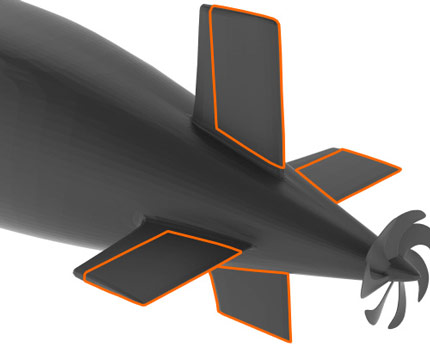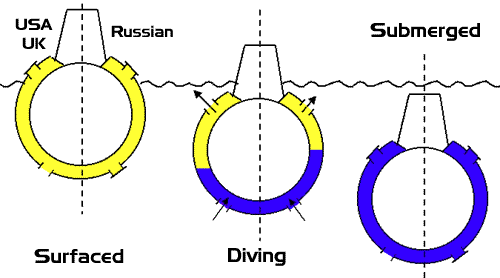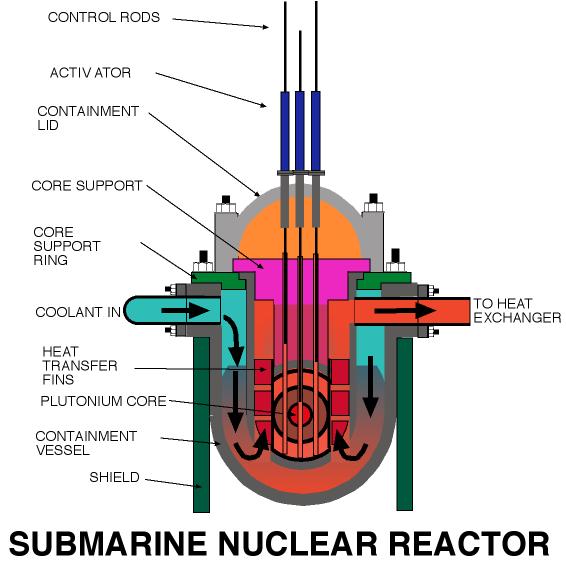Diving and Surfacing:
This aspect of submarines is simpler than it may seem. Submarines (or any ship) will float if the weight of the water it displaces is equal to that of the ship. They use something called buoyancy which is essentially the upwards force that the water creates, this force acts in opposition to gravity. Submarines can control their own buoyancy which allows the pilot to control whether or not the submarine will sink or float.
Submarines control their buoyancy by having tanks on their sides known as Ballast Tanks or Trim Tanks. These tanks can be filled with water to make the submarine dive, or they can be filled with compressed air to make the sub rise or float. Submarines also use a sort of fin on their tail known as hydroplanes to help with diving. These are essentially wings that can be adjusted to angle downwards or upwards. Their angle greatly helps with allowing the sub to dive or rise. To maintain its depth, the submarine just has to balance out how much air and water are in the ballast tanks so that it's equal to the density of the surrounding water, it also wants to make the hydroplanes maintain a level location so that it's not forcing the submarine up nor down.
Power Supply:
Submarines need power in order to continue operating underwater. There are a number of different ways in which subs are powered. The most common power sources, however, are diesel engines (with batteries) and nuclear reactors.
Submarines powered by diesel engines work like your car would, but on a much bigger scale. Many subs will have more than once diesel engine and run them simultaneously to perform different task. They can also work together with one driving the propeller and the other a generator. While the engines run, they charge up a huge bank of batteries which will then run and power everything once they're charged. Because when the submarine is running its diesel engines, it must remain at the surface so the engines have some sort of fuel supply, but once the batteries are charged the submarine can then dive under water.
Because of the limitations that diesel engines provide, many submarines are run by nuclear power or nuclear fission. Nuclear fission is essentially when an atom is split, releasing huge amounts of energy in the process. These nuclear reactors in submarines are almost identical to reactors used in power plants, just on a much smaller scale. One of the major benefits of using nuclear reactors is that they don't require oxygen to operate unlike the diesel engines. This allows the submarine to remain under water for very long periods of time. Nuclear fission also releases a lot more energy than diesel engines do, this way the submarine can store more energy and refuel less. Essentially, the submarine uses the heat derived from the nuclear fission to directly drive the propellers and run the electric generators.
This aspect of submarines is simpler than it may seem. Submarines (or any ship) will float if the weight of the water it displaces is equal to that of the ship. They use something called buoyancy which is essentially the upwards force that the water creates, this force acts in opposition to gravity. Submarines can control their own buoyancy which allows the pilot to control whether or not the submarine will sink or float.
 |
| Hydroplanes in a Submarine http://www.alseamar-alcen.com/sites/alseamar-alcen.com/files/produits/bmti_gouvernail.jpg |
Submarines control their buoyancy by having tanks on their sides known as Ballast Tanks or Trim Tanks. These tanks can be filled with water to make the submarine dive, or they can be filled with compressed air to make the sub rise or float. Submarines also use a sort of fin on their tail known as hydroplanes to help with diving. These are essentially wings that can be adjusted to angle downwards or upwards. Their angle greatly helps with allowing the sub to dive or rise. To maintain its depth, the submarine just has to balance out how much air and water are in the ballast tanks so that it's equal to the density of the surrounding water, it also wants to make the hydroplanes maintain a level location so that it's not forcing the submarine up nor down.
 |
| An example of how Ballast tanks on a
submarine help it dive and float. The yellow represents
the tanks filled with air and blue represents the tanks
filled with water. http://www.heiszwolf.com/subs/tech/flood.gif |
Power Supply:
Submarines need power in order to continue operating underwater. There are a number of different ways in which subs are powered. The most common power sources, however, are diesel engines (with batteries) and nuclear reactors.
Submarines powered by diesel engines work like your car would, but on a much bigger scale. Many subs will have more than once diesel engine and run them simultaneously to perform different task. They can also work together with one driving the propeller and the other a generator. While the engines run, they charge up a huge bank of batteries which will then run and power everything once they're charged. Because when the submarine is running its diesel engines, it must remain at the surface so the engines have some sort of fuel supply, but once the batteries are charged the submarine can then dive under water.
 |
| A diesel engine room inside a submarine.
http://www.saint-petersburg.com/images/museums/narodovolets-d-2-submarine/engine-room-in-the-narodovolets-submarine-in-st-petersburg.jpg |
Because of the limitations that diesel engines provide, many submarines are run by nuclear power or nuclear fission. Nuclear fission is essentially when an atom is split, releasing huge amounts of energy in the process. These nuclear reactors in submarines are almost identical to reactors used in power plants, just on a much smaller scale. One of the major benefits of using nuclear reactors is that they don't require oxygen to operate unlike the diesel engines. This allows the submarine to remain under water for very long periods of time. Nuclear fission also releases a lot more energy than diesel engines do, this way the submarine can store more energy and refuel less. Essentially, the submarine uses the heat derived from the nuclear fission to directly drive the propellers and run the electric generators.
 |
 |
| A Submarines Nuclear Reactor
http://large.stanford.edu/courses/2015/ph241/gerrard2/images/f3big.jpg |
The Nuclear Reactors
location in submarines. https://s-media-cache-ak0.pinimg.com/originals/f0/bb/fb/f0bbfbc41a22260554333326774990e4.jpg |
Previous Page -- Title Page -- Next Page